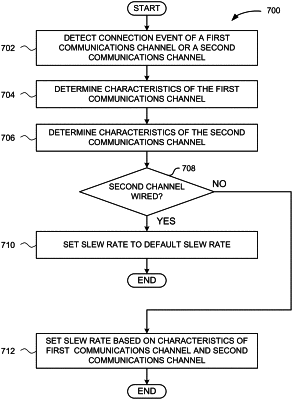| CPC H04L 47/22 (2013.01) [H04L 63/02 (2013.01); H04L 2012/2841 (2013.01); H04M 1/6091 (2013.01); H04W 84/14 (2013.01); H04W 92/10 (2013.01)] | 19 Claims |

|
1. A computer-implemented method for adjusting a slew rate of a signal associated with a wired communications channel, the method comprising:
detecting a first connection event associated with at least one of the wired communications channel or a wireless communications channel, wherein the first connection event includes at least one of: (1) a removal or attachment of a connector associated with the wired communications channel, or (2) a connection to or disconnection from a wireless communications channel;
determining a first set of characteristics associated with the wired communications channel, wherein the first set of characteristics includes a first mode that identifies at least one of a type of a physical interface or a data format of the physical interface;
determining a second set of characteristics associated with the wireless communications channel, wherein the second set of characteristics includes a second mode that identifies at least one of a frequency of the wireless communications channel or a bandwidth of the wireless communications channel, and wherein the first set of characteristics causes the wired communications channel to interfere with the wireless communications channel at one or more frequencies associated with the second set of characteristics; and
adjusting the slew rate of the signal to a first value based on the first set of characteristics and the second set of characteristics, wherein an insertion loss in the wired communications channel at the one or more frequencies increases when the slew rate is adjusted to the first value.
|